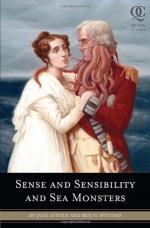|
This section contains 267 words (approx. 1 page at 400 words per page) |

|
Sense and Sensibility Summary & Study Guide Description
Sense and Sensibility Summary & Study Guide includes comprehensive information and analysis to help you understand the book. This study guide contains the following sections:
This detailed literature summary also contains Bibliography and a Free Quiz on Sense and Sensibility by Jane Austen.
Sense and Sensibility was first published in 1811, sixteen years after Jane Austen began the first draft, titled "Elinor and Marianne." Financed by Austen's brother and attributed only to "A Lady," it was the first of her novels to be put into print.
Austen is particularly known for her sharp portraits of early-nineteenth-century upper-class English society and for her remarkable talent in creating complex, vibrant characters. Sense and Sensibility is no exception. It is the story of two sisters, Elinor and Marianne Dashwood, who, as members of the upper class, cannot "work" for a living and must therefore make a suitable marriage to ensure their livelihood. The novel is a sharply detailed portraiture of the decorum surrounding courtship and the importance of marriage to a woman's livelihood and comfort.
The novel is also, as is most evident in its title, a comparison between the sisters' polar personalities. The eldest sister, Elinor, exemplifies the sense of the title—she is portrayed as a paragon of common sense and diplomatic behavior—while her younger sister Marianne personifies sensibility in her complete abandonment to passion and her utter lack of emotional control. In upholding Elinor's levelheaded and rational behavior and criticizing Marianne's romantic passions, Austen follows the form of the didactic novel, in which the personalities of two main characters are compared in order to find favor with one position and therefore argue against the other. Although rich in character development and wit, Sense and Sensibility is viewed as one of Austen's lesser works because of this formulaic approach, which Austen abandons in her more mature novels.
Read more from the Study Guide
|
This section contains 267 words (approx. 1 page at 400 words per page) |

|



